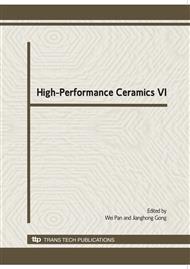[1]
J. Jiang, K. Bosnick, M. Maillard and L. Brus: J. Phys. Chem. B Vol. 107 (2003), p.9964.
Google Scholar
[2]
S. Nie and S. R. Emory: Science Vol. 275 (1997), p.1102.
Google Scholar
[3]
L. Ao, F. Gao, B. Pan, R. He and D. Cui: Anal. Chem. Vol. 78 (2006), p.1104.
Google Scholar
[4]
J. Z. Zhang, A. M. Schwartzberg, J. T. Norman, et al.: Nano Lett. Vol. 5 (2005), p.809.
Google Scholar
[5]
J. Matsui, K. Akamatsu, N. Hara, et al.: Anal. Chem. Vol. 77 (2005), p.4282.
Google Scholar
[6]
T. Liu, J. Tang, H. Zhao, Y. Deng and L. Jiang: Langmuir Vol. 18 (2002), p.5624.
Google Scholar
[7]
A. Yu, Z. Liang, J. Cho and F. Caruso: Nano Lett. Vol. 3 (2003), p.1203.
Google Scholar
[8]
C. J. Huang, P. H. Chiu, Y. H. Wang, et al: J. Electrochem. Soc. Vol. 153 (2006), p. D193.
Google Scholar
[9]
C. J. Huang, P. H. Chiu, M. D. Chen, et al.: Jpn. J. Appl. Phys. Part 2 Vol. 44 (2005), p. L941.
Google Scholar
[10]
C. J. Huang, P. H. Chiu, Y. H. Wang, et al.: J. Colloid Interface Sci. Vol. 306 (2007), p.56.
Google Scholar
[11]
C. J. Huang, P. H. Chiu, Y. H. Wang, et al.: Nanotechnology Vol. 18 (2007), p.395603.
Google Scholar
[12]
Y. G. Sun and Y. N. Xia: Science Vol. 298 (2002), p.2176.
Google Scholar
[13]
F. K. Lin and F. K. Ko: Chem. Lett. Vol. 33 (2004), p.902.
Google Scholar
[14]
H. Zhang, C. Shen, S. Chen, Z. Xu, F. Liu, J. Li and H. Gao: Nanotechnology Vol. 16 (2005), p.267.
Google Scholar
[15]
H. Zhu, Y. Wang, N. Wang, Y. Li and J. Yang: Mater. Lett. Vol. 58 (2004), p.2631.
Google Scholar
[16]
Q. Liu, Y. Ni, G. Yin, J. Hong and Z. Xu: Mater. Chem. Phys. Vol. 89 (2005), p.379.
Google Scholar
[17]
K. Yu, Y. Guo, X. Ding, J. Zhao and Z. Wang: Mater. Lett. Vol. 59 (2005), p.4013.
Google Scholar
[18]
S. Stankic, M. Müller, O. Diwald, et al.: Angew. Chem., Int. Ed. Vol. 44 (2005), p.4917.
Google Scholar
[19]
R. Liu, F. Oba, E. W. Bohannan, F. Ernst and J. A. Switzer: Chem. Mater. Vol. 15 (2003), p.4882.
Google Scholar
[20]
W. Lu, J. Fang, Y. Ding and Z. L. Wang: J. Phys. Chem. B Vol. 109 (2005), p.19219.
Google Scholar
[21]
Y. Yu, S. Chang, C. Lee and C. R. C. Wang: J. Phys. Chem. B Vol. 101 (1997), p.6661.
Google Scholar
[22]
S.S. Chang, C.W. Shih, C.D. Chen, et al.: Langmuir Vol. 15 (1999), p.701.
Google Scholar


